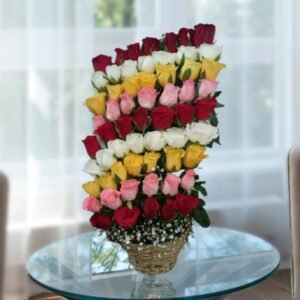Holi, also known as the “Festival of Colors,” is a vibrant and joyous celebration observed by Hindus and people of all religions worldwide. This festival commemorates the victory of good over evil, the arrival of spring, and the blooming of love and friendship. The significance and history of Holi are deeply rooted in ancient Hindu mythology, and the festival holds great cultural and social importance in India and other parts of the world. In this blog, we will explore the various facets of Holi, its history, and its importance in contemporary times.
The Mythological Roots of Holi
Holi has its roots in Hindu mythology and legends. The most popular myth behind the festival is the story of Holika and Prahlad. According to the legend, the evil king Hiranyakashipu was granted a boon by Lord Brahma that made him virtually indestructible. He believed that he was invincible and demanded that everyone worship him as a god. However, his son, Prahlad, was a devout follower of Lord Vishnu, which angered Hiranyakashipu. With immunity to fire, the king’s sister, Holika, deceived Prahlad into sitting on her lap in a bonfire with the intention of murdering him. However, to her dismay, Prahlad survived, while Holika burnt to death. This victory of good over evil is celebrated as Holi, and the bonfire symbolizes the triumph of virtue over vice.
The Joy of Colors and Spring
Apart from the mythological significance, Holi also has an agricultural significance. The festival is celebrated at the end of the winter season and the beginning of spring when the earth is rejuvenated with new life and colors. Holi marks the arrival of spring and the blossoming of flowers, making it a time of joy and celebration. People smear each other with colorful powders, dance to the beat of drums, and sing and revel in the warmth of the sun. The festival of Holi, therefore, is a celebration of the beauty of nature and the renewal of life.
Celebrating Holi Across India
Holi is a pan-India festival, celebrated with much gusto and fervor across the country. However, the customs and traditions associated with the festival differ from region to region. In Northern India, the festival is celebrated with great enthusiasm, and people take to the streets, splashing each other with colors and water. In Mathura and Vrindavan, the birthplace of Lord Krishna, the festival lasts for over a week and includes numerous rituals and performances, including the famous Lathmar Holi, where women playfully hit men with sticks. In South India, Holi is celebrated as Kama Dahanam, where people light a bonfire to symbolize the destruction of desire and lust. In West Bengal, the festival is known as Dol Jatra, where people dress up in saffron-colored clothes and play with colored water and powder.
You can buy Holi gifts here from our superb Holi gifting collection.
The Cultural Significance of Holi
Holi is not just a religious festival but has also taken on cultural and social significance in modern times. The festival is a time for people to forget their differences, come together, and spread joy and happiness. It is an occasion to celebrate diversity, as people from all walks of life and religions participate in the festivities. Holi is also a time to forgive and forget, mend broken relationships, and strengthen bonds of love and friendship. The festival is a reflection of the rich cultural heritage of India, and its celebration showcases the country’s vibrancy and diversity.
Holi Around the World
The spirit of Holi has transcended boundaries and has become a global festival celebrated with equal fervor by people of all nationalities and cultures. In recent years, Holi has gained popularity worldwide and has been celebrated in many countries, including the United States, United Kingdom, Canada, Australia, and New Zealand. Holi celebrations in these countries usually take place in public parks, community centers, and other venues where people can gather and enjoy the festivities. These celebrations often feature live music, dance performances, and food stalls serving traditional Indian delicacies.
-
Product on sale
 Customized Mug Of MemoriesOriginal price was: ₹ 499.00.₹ 249.00Current price is: ₹ 249.00.
Customized Mug Of MemoriesOriginal price was: ₹ 499.00.₹ 249.00Current price is: ₹ 249.00. -
Product on sale
 A Sweet JoyOriginal price was: ₹ 2,199.00.₹ 1,799.00Current price is: ₹ 1,799.00.
A Sweet JoyOriginal price was: ₹ 2,199.00.₹ 1,799.00Current price is: ₹ 1,799.00. -
Product on sale
 Yellow Carnations ArrangementOriginal price was: ₹ 999.00.₹ 849.00Current price is: ₹ 849.00.
Yellow Carnations ArrangementOriginal price was: ₹ 999.00.₹ 849.00Current price is: ₹ 849.00. -
Product on sale
 Pink Carnations And RasgullaOriginal price was: ₹ 1,499.00.₹ 1,199.00Current price is: ₹ 1,199.00.
Pink Carnations And RasgullaOriginal price was: ₹ 1,499.00.₹ 1,199.00Current price is: ₹ 1,199.00. -
Product on sale
 Layers Of RosesOriginal price was: ₹ 3,499.00.₹ 3,199.00Current price is: ₹ 3,199.00.
Layers Of RosesOriginal price was: ₹ 3,499.00.₹ 3,199.00Current price is: ₹ 3,199.00. -
Product on sale
 Carnations N Soan PapdiOriginal price was: ₹ 1,999.00.₹ 1,349.00Current price is: ₹ 1,349.00.
Carnations N Soan PapdiOriginal price was: ₹ 1,999.00.₹ 1,349.00Current price is: ₹ 1,349.00. -
Product on sale
 Yellow Roses N Dairy MilkOriginal price was: ₹ 1,999.00.₹ 1,499.00Current price is: ₹ 1,499.00.
Yellow Roses N Dairy MilkOriginal price was: ₹ 1,999.00.₹ 1,499.00Current price is: ₹ 1,499.00. -
Product on sale
 Carnations And Dry FruitsOriginal price was: ₹ 1,749.00.₹ 1,499.00Current price is: ₹ 1,499.00.
Carnations And Dry FruitsOriginal price was: ₹ 1,749.00.₹ 1,499.00Current price is: ₹ 1,499.00. -
Product on sale
 Sweet Festive SurpriseOriginal price was: ₹ 1,399.00.₹ 1,349.00Current price is: ₹ 1,349.00.
Sweet Festive SurpriseOriginal price was: ₹ 1,399.00.₹ 1,349.00Current price is: ₹ 1,349.00.
Safety Concerns and Precautions
While Holi is a fun and joyous festival, it is also essential to take safety precautions to ensure that everyone has a good time. The colored powders used during the celebrations can cause skin irritation, respiratory problems, and eye infections, especially if they contain harmful chemicals. It is, therefore, advisable to use organic or natural colors that are safe for the skin and the environment. It is also important to protect oneself by wearing clothes that cover most of the body and avoid inhaling the powders directly.
Conclusion
In conclusion, Holi is a festival that celebrates the arrival of spring, the victory of good over evil, and the joy of colors and love. Its roots lie in Hindu mythology and legends, but it has since become a cultural and social celebration, reflecting the diversity and richness of India’s heritage. The festival has gained popularity worldwide, and its celebration has become a symbol of harmony, unity, and friendship. While it is essential to take precautions during the celebrations, the festival is a time for people to come together, forget their differences, and celebrate life and love.
Overall, Holi is a festival that embodies the beauty and vibrancy of life, showcasing the power of love and unity to triumph over hatred and division. As we celebrate this joyous occasion, let us embrace the spirit of Holi and spread love, joy, and happiness to all those around us. Happy Holi!




